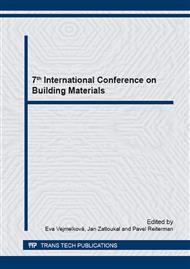[1]
Hegger, J., Voss, S., 2008, Investigations on the bearing behaviour and application potential of textile reinforced concrete, Engineering Structures, Vol. 30, p.2050-(2056).
DOI: 10.1016/j.engstruct.2008.01.006
Google Scholar
[2]
Barhum, R., Mechtcherine, V., 2013, Influence of short dispersed and short integral glass fibres on the mechanical behaviour of textile reinforced concrete, Materials and Structures, Vol. 46, pp.577-572.
DOI: 10.1617/s11527-012-9913-3
Google Scholar
[3]
T. Yen, K. S. Pann, Y. L. Huang, Strength Development of High Strength High-Performance Concrete at Early Ages, Structural Engineering, Mechanics and Computation, pp.1349-1356, (2001), ISBN: 978-0-08-043948-8.
DOI: 10.1016/b978-008043948-8/50150-8
Google Scholar
[4]
P. Reiterman, M. Jogl, V. Baumelt, J. Seifrt, 2014, Development and Mix Design of HPC and UHPFRC, Advanced Materials Research, Vol. 982, pp.130-135.
DOI: 10.4028/www.scientific.net/amr.982.130
Google Scholar
[5]
T. Pavlu, M. Šefflová, 2014, The Static and the Dynamic Modulus of Elasticity of Recycled Aggregate Concrete, Advanced Materials Research, Vol. 1054, pp.221-226.
DOI: 10.4028/www.scientific.net/amr.1054.221
Google Scholar
[6]
X. Ch. Wang, J. W Wang, H. T Liu, 2013, Experimental Research on Stress-Strain Curve of Carbon Fibre Reinforced Concrete, Advanced Materials Research, Vol. 668, pp.640-644.
DOI: 10.4028/www.scientific.net/amr.668.640
Google Scholar
[7]
H. Manal, Z. Yan, F. Bullen, L. Weena, 2011, Laboratory Evaluation of the Stress-Strain relationship of Permeable Concrete, Advanced Materials Research, Vol. 243, pp.3259-3262.
DOI: 10.4028/www.scientific.net/amr.243-249.3259
Google Scholar
[8]
T. Wang, Z. Hailong, H. Jinjin, Z. Jianquan, 2011, Research on Compressive Stress-Strain Relationship of Fibre Reinforced Concrete, Advanced Materials Research, Vols. 168-170, pp.384-392.
DOI: 10.4028/www.scientific.net/amr.168-170.384
Google Scholar
[9]
P. R. L. Lima, R. D. T. Filho, J. A. M. Filho, 2014, Compressive Stress-strain Behaviour of Cement Mortar-composites Reinforced with Short Sisal Fibre, Material Research, Vol. 17(1), pp.38-46.
DOI: 10.1590/s1516-14392013005000181
Google Scholar
[10]
CSN EN 206 – 1 Concrete – Part 1: Specification, performance, production and conformity, CNI, Prague (2001).
Google Scholar
[11]
F. Vogel, O. Holčapek, P. Konvalinka, 2014, Study of Strength Development of the Cement Matrix for Textile Reinforced Concrete, Advance Materials Research, Vol. 1054, pp.99-103.
DOI: 10.4028/www.scientific.net/amr.1054.99
Google Scholar
[12]
F. Vogel, O. Holčapek, M. Jogl, K. Kolář, P. Konvalinka, 2014, Development of Mechanical Properties of Steel Fibers Reinforced High Strength Concrete, Advance Materials Research, Vol. 1077, pp.113-117.
DOI: 10.4028/www.scientific.net/amr.1077.113
Google Scholar


